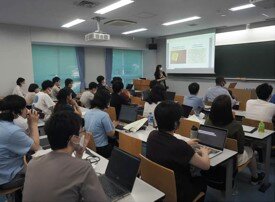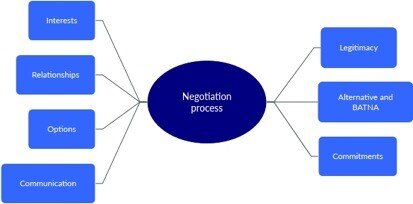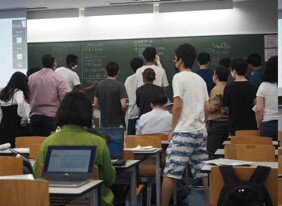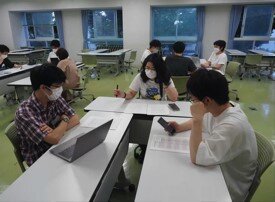(英語のみ。)
Ms. Mayu Watanabe (Ph.D) is a specially appointed Associate Professor at Rikkyo University. She is a member of several institutions such as the Stanford Law School (Gould Negotiation and Mediation Program), the NCTDR (National Center for Technology and Dispute Resolution) of the University of Massachusetts and the Weinstein International Foundation. She is a representative of lead academic institution (APEC ODR framework) and a committee member of Ministry of Justice. She is also the founder and director of the Japan Association for Online Dispute Resolution. She gave two days of intensive lectures on the negotiation process at TokyoTech for ToTal students and open TokyoTech students. The first day was devoted to the basic concepts of the negotiation process and role plays on negotiation. And the second day was dedicated to the basic concepts of the mediation process and role plays on negotiation and mediation processes.
- Day 1.
What is a negotiation?
“A negotiation is an interactive communication process that may take place whenever you want something from someone else or another person wants something from you”
There are two ways to resolve a dispute before going to trial, the first way is the Alternative Dispute Resolution (ADR) which includes negotiation, mediation, and arbitration processes and the second way is the Online Dispute Resolution (ODR) if the dispute took place online. Negotiation involves both litigating parties, where mediation involves the assistance of a neutral third party and arbitration involves the implication of several neutral and independent third parties. Alternative dispute resolution methods become more expensive in terms of time and resources, mediation and arbitration are more costly to implement than negotiation. Thus, the negotiation process is a cost-effective and efficient way to resolve a dispute. It requires verbal and non-verbal communication skills and is the result of the coordination of intelligence quotient and social-emotional quotient which encompasses with your originality, social insight, negotiation skills and persuasion. There are four important concepts in the negotiation process such as the best alternative to a negotiated agreement (BATNA), the reservation price, the area of possible agreement (ZOPA) and the creation of value through exchanges. Potential cognitive biases such as anchoring effect, can affect the reservation price and the aspiration of negotiation outcomes. Furthermore, there are four negotiation styles such as accommodation, avoidance, compromise, competition, and collaboration.
On the first day, the students carried out a role play on selling/buying a used car and were divided into several “buyer” and “seller” pairs. Each pair negotiated the used car considering its technical characteristics, sentimental background, and market price; and reached a negotiated price agreement. In addition, students gained a better understanding of several important concepts of negotiation process such as BATNA, ZOPA and reservation price. Students also did another exercise identifying and discussing their negotiation styles.


- Day 2
In the negotiation process, real interests are difficult to emerge where positions are clearly stated in the process, and it requires creative thinking and solutions to unfold these interests. In addition, fairness and emotion can influence a negotiation, for example the latter can influence the relationship between negotiators, communication, interests, negotiation options, legitimacy, BATNA and commitments. Furthermore, there are five basic concerns to consider in a negotiation, such as:
・Appreciation: The value placed on thoughts, feelings, and actions,
・Affiliation: The strength of the relationship between the negotiators,
・Autonomy: The degree of decision-making freedom,
・Status: The recognition from others,
・And role: The definition of the role and activities.


Power and posture are also very important and linked in negotiation, for example an expansive posture tends to show more power and self-confidence than a constricted posture which shows the opposite. If a final agreement is not reached to resolve the dispute, side agreements or a contingency agreement can be concluded. The contingency agreement is the settlement of agreements that depend on the outcome of certain events. The mediation is a negotiation carried out with the assistance of a third party, the process is consensual, informal, and private. Mediation can be evaluative by offering suggestions for a positive resolution, and facilitative by assisting the parties in creating and evaluating a resolution. The mediator can meet the parties individually or together with their consent.

Figure 1: Elements of negotiation
For the second day of the lecture, students participated in two role plays. The first roleplay was the business negotiation, the students were divided into several “talent agent” and “Vice President of the theater” pairs and negotiated talent’s salary for a particular job at the theater. Discussions were held on the interests, alternatives, ZOPA and BATNA of both parties. Negotiated salaries and side agreements of each pair were discussed in class.
The second role play was on the community dispute case, the students were divided into groups of “church representative”, “neighbor representative” and “mediator” trios. Each trio discussed about a community dispute over the church’s decision to lease space in the building to a nonprofit organization. The main objective was to reach an agreement with the help of a mediator. Students experienced a mediation process and further discussions took place on mediation styles and the role of the mediator.


****
Reported by (Abdek Mahamoud Abdi, D2, Dept. of Transdisciplinary Science and Engineering (Open student)


